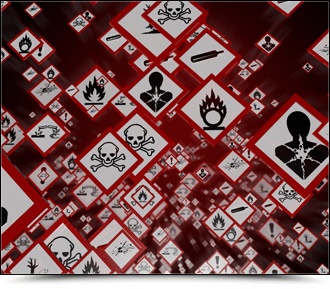How to Make Sure Your Business is GHS Compliant

The Globally Harmonized System (GHS) of Classification and Labeling of Chemicals has been used by countries around the world since its introduction in 2003, but its mandatory nature is far less established. In an effort to unify standards, OSHA decided to bring its Hazard Communication Standard (HCS) in line with the GHS, ensuring the same format is used by companies engaging in commerce domestically and abroad.
The Benefits of GHS Compliance
“Appropriate labeling of chemicals stored in all forms is critical for GHS compliance.”
The mandatory nature of the GHS standards means organizations must follow them. If organizations fail to comply with GHS standards, they leave themselves vulnerable to fines and penalties. Taking a strong approach to full compliance keeps businesses safe and makes transactions along the supply chain easier, as all parties involved have access to the same information stored in the same format. As the time from the final deadline continues to grow, a lack of GHS compliance could translate to significant complications.
Now is the time to prepare and implement key components to meet the requirements. Prepare your business for GHS compliance by taking these four steps:
1. Learn about what has changed
- Signs and Labels: Each hazard category and class must be accompanied by a hazard statement and pictogram on the label.
- Safety Data Sheets: Formerly called Material Safety Data Sheets (MSDS), these sheets provide information about the hazards associated with chemical management at workplaces and provide recommendations for safety measures. There must now be a standard format with 16 sections, per OSHA brief.
- Hazard Classification: In addition to the current definition of hazard, specific criteria have been added to classify health and physical hazards, and mixtures. In so doing, manufacturers will be able to evaluate hazardous effects consistently, which will help ensure more accurate labeling and safety data sheets.
2. Train your employees
Current employees should have been trained on the new label elements and SDS formats by December 1, 2013. However, whenever new employees are hired it is mandatory to train them in the same manner, and also when a new health or physical hazard is introduced, all employees must be trained. Training should be provided on how to interpret new pictograms, understand updated labels, and understand new warnings, signal words, and precaution statements. To ensure workplace safety and meet OSHA requirements, it is crucial to communicate these hazards.
3. Replace current MSDSs with SDSs
To maintain compliance with GHS, make sure the SDSs you receive include new hazard information. An SDS must include the 16 required sections in the specified order and in a uniform format with headings, section numbers, and associated information.
4. Choose the right signs and labels
Chemical labels under GHS must include the following1:
- Hazard Statement: This describes the nature of the product’s hazard with a phrase assigned to the hazard class.
- Pictogram: This is a graphic symbol that is intended to visually convey specific hazard information and must include a red border (or black border for workplace labels only).
- Signal Word: It must use either “Danger” (severe) or “Warning” (less severe).
- Product Identifier: This should be identical to the product identifier on the SDS.
- Supplier Identification: The name, telephone number, and address of the supplier or manufacturer must be listed.
- Precautionary Statement: This describes recommended measures to reduce or prevent adverse effects resulting from exposure.
An organized and effective GHS process helps businesses achieve compliance. For assistance selecting the right signage, labels, and more, give us a call at (866) 748-5963 today!
